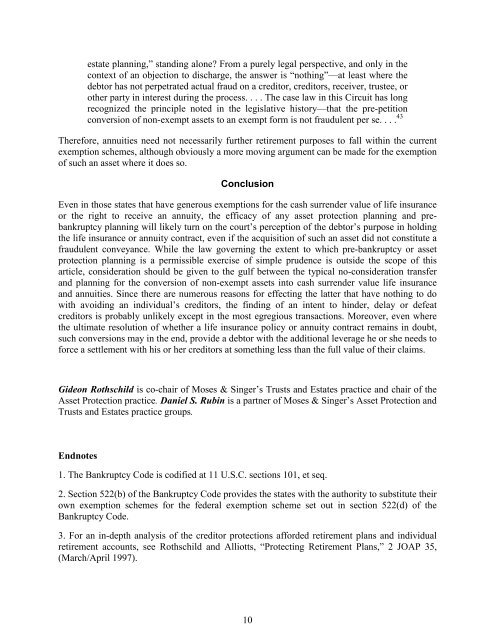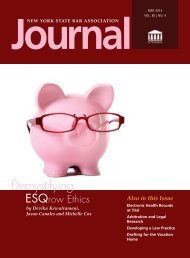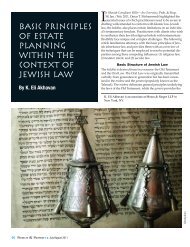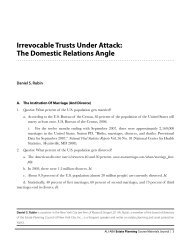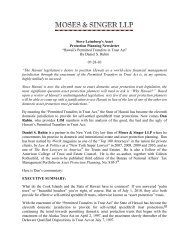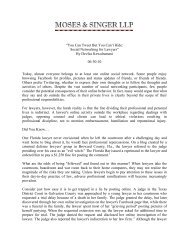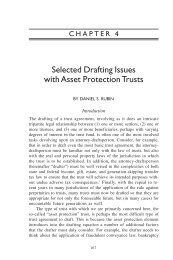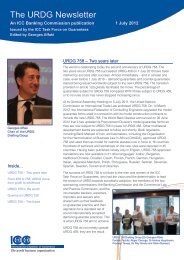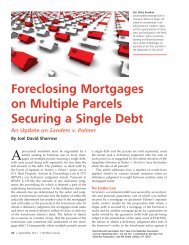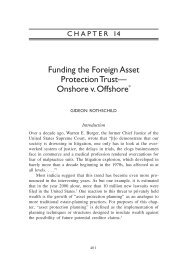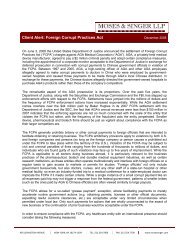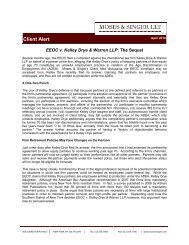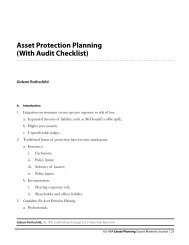Creditor Protection for Life Insurance and Annuities
Creditor Protection for Life Insurance and Annuities
Creditor Protection for Life Insurance and Annuities
You also want an ePaper? Increase the reach of your titles
YUMPU automatically turns print PDFs into web optimized ePapers that Google loves.
estate planning,” st<strong>and</strong>ing alone? From a purely legal perspective, <strong>and</strong> only in the<br />
context of an objection to discharge, the answer is “nothing”—at least where the<br />
debtor has not perpetrated actual fraud on a creditor, creditors, receiver, trustee, or<br />
other party in interest during the process. . . . The case law in this Circuit has long<br />
recognized the principle noted in the legislative history—that the pre-petition<br />
conversion of non-exempt assets to an exempt <strong>for</strong>m is not fraudulent per se. . . . 43<br />
There<strong>for</strong>e, annuities need not necessarily further retirement purposes to fall within the current<br />
exemption schemes, although obviously a more moving argument can be made <strong>for</strong> the exemption<br />
of such an asset where it does so.<br />
Conclusion<br />
Even in those states that have generous exemptions <strong>for</strong> the cash surrender value of life insurance<br />
or the right to receive an annuity, the efficacy of any asset protection planning <strong>and</strong> prebankruptcy<br />
planning will likely turn on the court’s perception of the debtor’s purpose in holding<br />
the life insurance or annuity contract, even if the acquisition of such an asset did not constitute a<br />
fraudulent conveyance. While the law governing the extent to which pre-bankruptcy or asset<br />
protection planning is a permissible exercise of simple prudence is outside the scope of this<br />
article, consideration should be given to the gulf between the typical no-consideration transfer<br />
<strong>and</strong> planning <strong>for</strong> the conversion of non-exempt assets into cash surrender value life insurance<br />
<strong>and</strong> annuities. Since there are numerous reasons <strong>for</strong> effecting the latter that have nothing to do<br />
with avoiding an individual’s creditors, the finding of an intent to hinder, delay or defeat<br />
creditors is probably unlikely except in the most egregious transactions. Moreover, even where<br />
the ultimate resolution of whether a life insurance policy or annuity contract remains in doubt,<br />
such conversions may in the end, provide a debtor with the additional leverage he or she needs to<br />
<strong>for</strong>ce a settlement with his or her creditors at something less than the full value of their claims.<br />
Gideon Rothschild is co-chair of Moses & Singer’s Trusts <strong>and</strong> Estates practice <strong>and</strong> chair of the<br />
Asset <strong>Protection</strong> practice. Daniel S. Rubin is a partner of Moses & Singer’s Asset <strong>Protection</strong> <strong>and</strong><br />
Trusts <strong>and</strong> Estates practice groups.<br />
Endnotes<br />
1. The Bankruptcy Code is codified at 11 U.S.C. sections 101, et seq.<br />
2. Section 522(b) of the Bankruptcy Code provides the states with the authority to substitute their<br />
own exemption schemes <strong>for</strong> the federal exemption scheme set out in section 522(d) of the<br />
Bankruptcy Code.<br />
3. For an in-depth analysis of the creditor protections af<strong>for</strong>ded retirement plans <strong>and</strong> individual<br />
retirement accounts, see Rothschild <strong>and</strong> Alliotts, “Protecting Retirement Plans,” 2 JOAP 35,<br />
(March/April 1997).<br />
10


